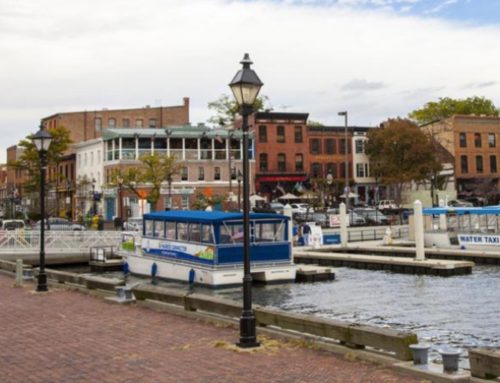Excerpt from the Baltimore Sun:
Set on a steep hill with winding sidewalks and narrow shops, Ellicott City’s Main Street wasn’t built with wheelchairs and walkers in mind.
Today, with more than 2 million Americans using wheelchairs and more than 6 million relying on walkers, canes or crutches for assistance, according to National Institute of Health data, the need for city streets and shops to accommodate those with limited mobility has become much more pressing.
As planning begins for a major revamp of Main Street, which could include a new parking garage and new sidewalks, residents are wondering how the historic district can be made more accessible.
Members of the county’s Commission on Disability Issues have started talks with officials from the county’s Department of Planning and Zoning about how the area can be improved. The commission is planning a tour in the coming weeks with members of the Department of Planning and Zoning, to show them some of their specific concerns.
Department of Planning and Zoning Deputy Director Peter Conrad said he’s been “delighted” to work with the commission on accessibility issues and that accessibility has been on the department’s radar the entire time they’ve been discussing the district’s revitalization. But Conrad noted that “it’s a challenging environment, there’s very little room to work with,” when looking at where to add parking or widen sidewalks.
Commission member Elliott Finkelstein raised the issue at one of the county’s recent Ellicott City Watershed Master Plan public workshops, and said that with limited handicapped-designated parking spaces, narrow sidewalks and steps leading into many stores, he’s forced to largely avoid the area. Finkelstein uses a power wheelchair, a device that weighs several hundred pounds, making it nearly impossible to lift over curbs or steps into shops.
“How do you fit the modern types of access in a historic community? That’s a tough one to do,” Finkelstein said. “Not all the stores are going to be able to welcome the requirements that are needed — they’re narrow buildings with narrow floorways and narrow halls. [You’ve] just got to do the best you can. Of course when you can’t accommodate people, you lose business.”
That potential for a loss of business is what commission member Marian Vessels, who also uses a power wheelchair, said should drive more businesses in the area to make their buildings more accessible.
“As we’re reconstructing what we think Ellicott City should be, how is it that we can make these very old streets and buildings more accessible,” Vessels said. “Stores can lose out on sales if people can’t get in the stores.”
Main Street is home to more than 60 businesses, nearly all of which are in historic buildings, making for a lengthy process to change the exterior of a building to add accommodations like ramps.
Howard County enforces Maryland’s Accessibility Code, which includes the 2010 Americans with Disability Act standards. However, when the owner of a historic building wants to make changes to its exterior, that request must be reviewed by the county’s five-member Historic Preservation Commission, who must approve the changes by a majority vote, according to Beth Burgess, chief of the Department of Planning and Zoning’s resource conservation division.
Burgess said the commission most commonly reviews requests for adding railings to storefronts, and that in her six years in the division, the commission has never denied a request. The commission, she said, tries to be “lenient” with property owners to ensure their buildings can be made accessible while still maintaining their historic integrity.
For minor alterations like railings, Burgess said the process can take as little as a week, and that last year the commission approved approximately 60 minor alterations. Larger changes, such as widening a storefront door frame or building a permanent ramp, can take up to two months to be approved.
The county also has a set of Ellicott City Historic District Design Guidelines, meant to ensure property owners maintain the historic integrity of the area. Those guidelines include provisions such as recommendations against replacing a building’s original front doors and to preserve the “form and detail” of historic storefronts, making it difficult to update those features to be more accommodating.
The guidelines, which are more than 20 years old, don’t include any mention of ADA compliance, but Burgess said the department is in the midst of creating an updated version to include that compliance. Burgess said the new guidelines, which are expected to be published by the end of 2018, would include recommendations for making historic buildings more accessible and expectations for how new buildings in the district can meet ADA standards.
Despite these challenges, some store owners, such as Megan Clark, owner of Curious Minds Toys, do want to make their shops more accessible. Clark said she wants to add a ramp to the front of her store, which has two steps up to the front door, but admitted she is intimidated by the process to get such a change approved.
Clark said she wants to add the feature to make her store easier to enter for her customers, many of whom are grandparents and struggle with mobility.
“There’s a big need for it,” she said. “It benefits my customers, and my customers come first.”
Others, such as Maxine’s Antiques and Collectibles owner Charlene Townsend, said the greatest need isn’t to change stores like hers, but to add features such as a crosswalk in the mid-section of Main Street. She wants to make it safer for people using wheelchairs and walkers to cross the mid-section of the street, rather than having to go to the top or bottom of the steep hill.
Townsend said she’s opposed to widening sidewalks, since it could mean losing out on street parking for customers, a common concern among shop owners in the area, many of whom are desperate to keep what limited street parking there is.
Finkelstein and Vessels both said they’re realistic about what they expect to be changed in the historic district. Even minor changes, such as adding a doorbell to a shop so staff know if someone has arrived who may need assistance, or buying a temporary, movable ramp shared by businesses, would be helpful, Vessels said.
“I’m a realist. I don’t really expect every business [to change], especially in that kind of a setting,” Finkelstein said. “Everybody has certain limitations, and I can’t expect that businesses make it easy for me to have exactly the best seat in the house. I would like to be able to go up and down the sidewalks, to be able to go into a few of the stores, a few of the restaurants.”


